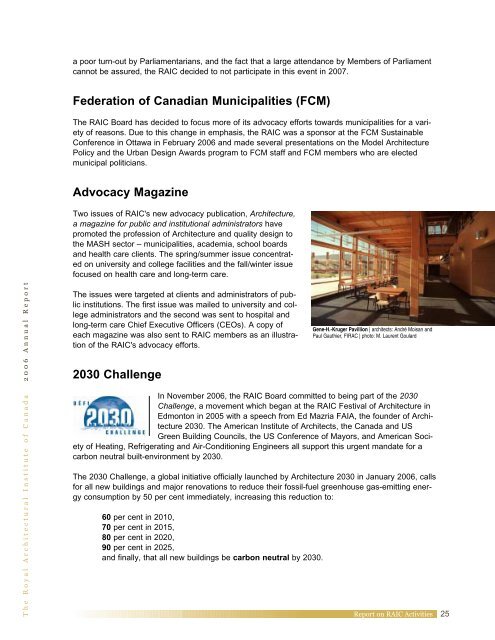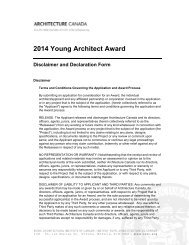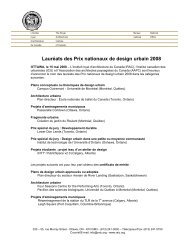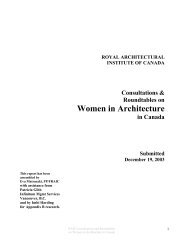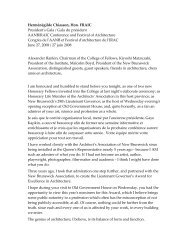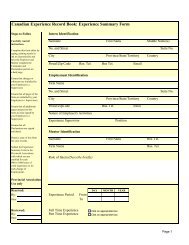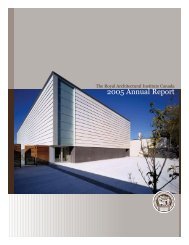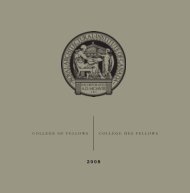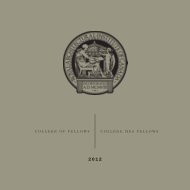RAIC 2006 Annual Report - Royal Architectural Institute of Canada
RAIC 2006 Annual Report - Royal Architectural Institute of Canada
RAIC 2006 Annual Report - Royal Architectural Institute of Canada
You also want an ePaper? Increase the reach of your titles
YUMPU automatically turns print PDFs into web optimized ePapers that Google loves.
a poor turn-out by Parliamentarians, and the fact that a large attendance by Members <strong>of</strong> Parliament<br />
cannot be assured, the <strong>RAIC</strong> decided to not participate in this event in 2007.<br />
Federation <strong>of</strong> Canadian Municipalities (FCM)<br />
The <strong>RAIC</strong> Board has decided to focus more <strong>of</strong> its advocacy efforts towards municipalities for a variety<br />
<strong>of</strong> reasons. Due to this change in emphasis, the <strong>RAIC</strong> was a sponsor at the FCM Sustainable<br />
Conference in Ottawa in February <strong>2006</strong> and made several presentations on the Model Architecture<br />
Policy and the Urban Design Awards program to FCM staff and FCM members who are elected<br />
municipal politicians.<br />
The <strong>Royal</strong> <strong>Architectural</strong> <strong>Institute</strong> <strong>of</strong> <strong>Canada</strong> <strong>2006</strong> <strong>Annual</strong> <strong>Report</strong><br />
Advocacy Magazine<br />
Two issues <strong>of</strong> <strong>RAIC</strong>'s new advocacy publication, Architecture,<br />
a magazine for public and institutional administrators have<br />
promoted the pr<strong>of</strong>ession <strong>of</strong> Architecture and quality design to<br />
the MASH sector – municipalities, academia, school boards<br />
and health care clients. The spring/summer issue concentrated<br />
on university and college facilities and the fall/winter issue<br />
focused on health care and long-term care.<br />
The issues were targeted at clients and administrators <strong>of</strong> public<br />
institutions. The first issue was mailed to university and college<br />
administrators and the second was sent to hospital and<br />
long-term care Chief Executive Officers (CEOs). A copy <strong>of</strong><br />
each magazine was also sent to <strong>RAIC</strong> members as an illustration<br />
<strong>of</strong> the <strong>RAIC</strong>'s advocacy efforts.<br />
2030 Challenge<br />
In November <strong>2006</strong>, the <strong>RAIC</strong> Board committed to being part <strong>of</strong> the 2030<br />
Challenge, a movement which began at the <strong>RAIC</strong> Festival <strong>of</strong> Architecture in<br />
Edmonton in 2005 with a speech from Ed Mazria FAIA, the founder <strong>of</strong> Architecture<br />
2030. The American <strong>Institute</strong> <strong>of</strong> Architects, the <strong>Canada</strong> and US<br />
Green Building Councils, the US Conference <strong>of</strong> Mayors, and American Society<br />
<strong>of</strong> Heating, Refrigerating and Air-Conditioning Engineers all support this urgent mandate for a<br />
carbon neutral built-environment by 2030.<br />
The 2030 Challenge, a global initiative <strong>of</strong>ficially launched by Architecture 2030 in January <strong>2006</strong>, calls<br />
for all new buildings and major renovations to reduce their fossil-fuel greenhouse gas-emitting energy<br />
consumption by 50 per cent immediately, increasing this reduction to:<br />
60 per cent in 2010,<br />
70 per cent in 2015,<br />
80 per cent in 2020,<br />
90 per cent in 2025,<br />
and finally, that all new buildings be carbon neutral by 2030.<br />
Gene-H.-Kruger Pavillion | architects: André Moisan and<br />
Paul Gauthier, FIRAC | photo: M. Laurent Goulard<br />
<strong>Report</strong> on <strong>RAIC</strong> Activities<br />
25


